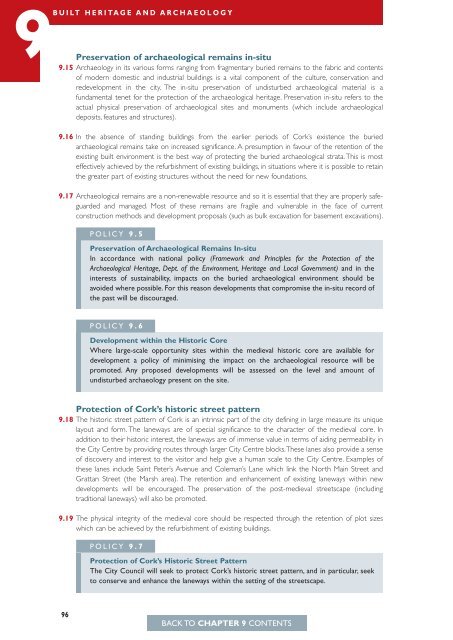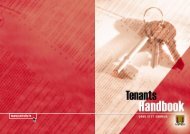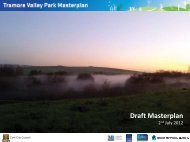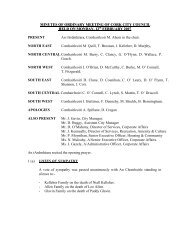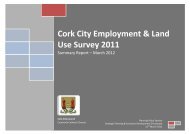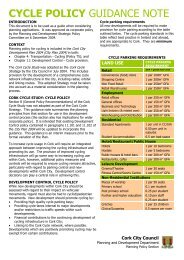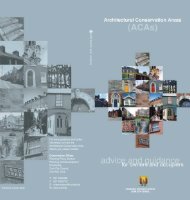Development Plan Chapter 9 Built Heritage - Cork City Council
Development Plan Chapter 9 Built Heritage - Cork City Council
Development Plan Chapter 9 Built Heritage - Cork City Council
Create successful ePaper yourself
Turn your PDF publications into a flip-book with our unique Google optimized e-Paper software.
9BUILT HERITAGE AND ARCHAEOLOGY<br />
Preservation of archaeological remains in-situ<br />
9.15 Archaeology in its various forms ranging from fragmentary buried remains to the fabric and contents<br />
of modern domestic and industrial buildings is a vital component of the culture, conservation and<br />
redevelopment in the city. The in-situ preservation of undisturbed archaeological material is a<br />
fundamental tenet for the protection of the archaeological heritage. Preservation in-situ refers to the<br />
actual physical preservation of archaeological sites and monuments (which include archaeological<br />
deposits, features and structures).<br />
9.16 In the absence of standing buildings from the earlier periods of <strong>Cork</strong>’s existence the buried<br />
archaeological remains take on increased significance. A presumption in favour of the retention of the<br />
existing built environment is the best way of protecting the buried archaeological strata. This is most<br />
effectively achieved by the refurbishment of existing buildings, in situations where it is possible to retain<br />
the greater part of existing structures without the need for new foundations.<br />
9.17 Archaeological remains are a non-renewable resource and so it is essential that they are properly safeguarded<br />
and managed. Most of these remains are fragile and vulnerable in the face of current<br />
construction methods and development proposals (such as bulk excavation for basement excavations).<br />
POLICY 9.5<br />
Preservation of Archaeological Remains In-situ<br />
In accordance with national policy (Framework and Principles for the Protection of the<br />
Archaeological <strong>Heritage</strong>, Dept. of the Environment, <strong>Heritage</strong> and Local Government) and in the<br />
interests of sustainability, impacts on the buried archaeological environment should be<br />
avoided where possible. For this reason developments that compromise the in-situ record of<br />
the past will be discouraged.<br />
POLICY 9.6<br />
<strong>Development</strong> within the Historic Core<br />
Where large-scale opportunity sites within the medieval historic core are available for<br />
development a policy of minimising the impact on the archaeological resource will be<br />
promoted. Any proposed developments will be assessed on the level and amount of<br />
undisturbed archaeology present on the site.<br />
Protection of <strong>Cork</strong>’s historic street pattern<br />
9.18 The historic street pattern of <strong>Cork</strong> is an intrinsic part of the city defining in large measure its unique<br />
layout and form. The laneways are of special significance to the character of the medieval core. In<br />
addition to their historic interest, the laneways are of immense value in terms of aiding permeability in<br />
the <strong>City</strong> Centre by providing routes through larger <strong>City</strong> Centre blocks.These lanes also provide a sense<br />
of discovery and interest to the visitor and help give a human scale to the <strong>City</strong> Centre. Examples of<br />
these lanes include Saint Peter’s Avenue and Coleman’s Lane which link the North Main Street and<br />
Grattan Street (the Marsh area). The retention and enhancement of existing laneways within new<br />
developments will be encouraged. The preservation of the post-medieval streetscape (including<br />
traditional laneways) will also be promoted.<br />
9.19 The physical integrity of the medieval core should be respected through the retention of plot sizes<br />
which can be achieved by the refurbishment of existing buildings.<br />
POLICY 9.7<br />
Protection of <strong>Cork</strong>’s Historic Street Pattern<br />
The <strong>City</strong> <strong>Council</strong> will seek to protect <strong>Cork</strong>’s historic street pattern, and in particular, seek<br />
to conserve and enhance the laneways within the setting of the streetscape.<br />
96


